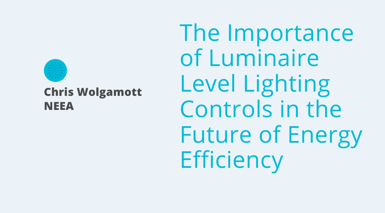Last month we summarized some of the important takeaways from the latest Networked Lighting Control energy savings evaluation presented by the DesignLights Consortium®, in partnership with the Northwest Energy Efficiency Alliance (NEEA). In short, the report indicates an increase in energy savings when NLCs are properly commissioned.
Will Walker caught up with Chris Wolgamott, a Senior Product Manager of Technology and Product Management for NEEA where he directs and supports a number of technology initiatives in partnership with utilities and related organizations across the United States. Chris played a key role in the latest NLC analysis and spoke with us about why a subset of this year's study, Luminaire Level Lighting Controls (LLLC) are so important to the future of energy efficiency.
Will: Thanks for taking some time to speak with us today Chris, and congratulations on the latest NLC savings report. You must be excited to see the savings potential of NLCs confirmed again and the indications that there is even more savings potential if NLCs are paired with LLLCs.
Chris: Thanks Will. We are excited, and happy to see LLLCs get some more attention.
Will: There are several control categories (NLC, LLLC, Integrated, Stand-Alone, etc), what makes LLLCs unique or different from other lighting control options?
Chris: Good question. LLLCs are luminaires with an embedded lighting control logic, occupancy, and ambient light sensors. Each luminaire shall also have wireless networking capabilities to detect and share information with other fixtures to adjust to occupancy and/or daylight in the space. Lighting Controls Logic means that the luminaire is capable of operating in an energy efficiency mode even if the connectivity with other luminaires is not functioning. This is the definition that NEEA uses; the DLC® uses a slightly different definition: The capability to have a networked occupancy sensor and ambient light sensor installed for each luminaire or kit, and directly integrated or embedded into the form factor during the luminaire or kit manufacturing process. The key difference is “wireless” so the joint report uses the DLC® definition.
Will: Interesting, I didn’t realize they could operate independently on a network.
Chris: That’s right, you can deliver more savings on a luminaire by luminaire basis assuming the network is hosting LLLCs.
Will: Seems like that could create a lot of flexibility for system owners/operators and I imagine would be a large demand. The study though focused more broadly on NLCs. Is this reflective of slower LLLC adoption?
Chris: Yes, there appears to be a knowledge gap, for both the installers and the business owners. At present, business owners are not aware of the benefits of LLLC (both energy and non-energy), and thus are not requesting them when it is time to upgrade their lighting system. Likewise, contractors need to be comfortable to not only bid LLLC but also be able to do the installation and programing of the systems. The bidding is particularly difficult if a business owner is shopping on system price, putting the contractor in a position to sell a lighting system on first cost vs operating cost and feature benefit.
Will: If there are extra energy savings, I wonder if there’s a place for utility efficiency rebates to help overcome some of the financial obstacles. How do you see LLLCs fitting into their rebate and incentive portfolios?
The best way would be if the utilities were able to create an incentive program that looked at LLLC as a system.
Chris: The best way would be if the utilities were able to create an incentive program that looked at LLLC as a system and created an incentive that was for both the upgraded luminaire and the controls savings, creating a single incentive for the system (could be $x per luminaire). Another option is a pay-for-performance program. Each utility is going to have to decide what fits best with their customer base.
Will: Energy savings seem like the obvious answer, but why would a utility care about LLLCs?
We are seeing greater energy savings with LLLC than any other lighting controls system out there.
Chris: There are several reasons that they will be important to utilities going forward. The biggest would be increased energy savings from the controls, we are seeing greater energy savings with LLLC than any other lighting controls system out there. Along with the energy savings, LLLC presents the ability to have better persistence of energy savings, by this I mean that utilities are less likely to see these controls “turned off” over time because the user does not like how the controls are working. LLLC gives you the ability to have each luminaire or zone controlled separately which means the lighting can be customized down to the luminaire level making it less likely that the whole system will be deactivated because one sensor is disabled. As the adoption of LEDs increases, utilities are going to have a more difficult time justifying incentives for lighting upgrades because the baseline is becoming LEDs, so they need lighting controls to help them continue to have incentives for non-residential lighting programs. LLLC not only presents the possibility of the most energy savings but they also have the potential to be used to control other building systems, like HVAC, with the sensor network that is present within all the luminaires in the LLLC system. This presents an opportunity for the utilities to not only increase the lighting controls savings but also better and more accurate building system (like HVAC) operations which can translate into more energy savings from other building systems
Will: Thanks Chris, this has been really helpful. Appreciate you taking time to unpack some of this. Most of our readers come from the lighting industry, any final thoughts or comments that should take away?
Chris: We’d love to see more data. It is vital for us to know how many of these systems are being installed. NEEA does an incremental price study on a regular basis and knowing that data helps utilities decide on incentive levels so continuing to participate in that research is incredibly important. The other thing is to make sure that we work together to continue to make the product even easier to get, program, and show the non-energy benefits that it can provide to the business owners.
Will: Makes sense, data reveals insights, insights lead to improved products and hopefully more and better efficiency rebates. Thanks again Chris!
You can catch up with Chris on LinkedIn.
Chris Wolgamott
Senior Product Manager of Technology and Product Management, NEEA
.png?width=500&name=2019%20e%20news%20spotlight%20logo%20(1).png)





